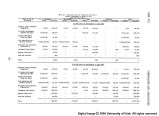| OCR Text |
Show PART VIII RECOMMENDATIONS 9« Continue development of improved plant and crop species, fer- tilizers, and insect and disease control on dry and irrigated cropland to meet the increased food and fiber production requirements. 10. Expand the range, treatment, and management program to approach the optimum of 8.2+ million AUM's per annum of production for livestock and wildlife grazing. 11. Accelerate the intensive forest management program to utilize the harvestable timber resource through improved marketing and expanded harvest management. These programs include timber stand improvement practices, increased protection from insects, fire, and disease, and im- proved forest product utilization. 12. Include provisions for investigation and salvage of the archeo- logical resources in feasibility studies. 13* Study free-flowing rivers, and others of high quality to deter- mine their suitability for inclusion in a national or state system of wild, scenic, or recreational rivers. Those found suitable for such des- ignation should be given protection by enactment of appropriate legisla- tion. lh. Determine more clearly the optimum carrying capacities and best uses of existing and potential recreation land and water resources. When this information is available, a system to regulate kinds and amounts of recreation activities at each area should be implemented to avoid overuse and insure quality recreation experiences. 15* Develop and apply an objective system for evaluating environ- mental assets associated with water resource and other developments on a par with economic considerations. 16. Protect outstanding natural, primitive, and historic and cul- tural areas by expansion and establishment of wilderness areas, national parks, national monuments, and national recreation areas. 17* Routing of utilities, land transportation facilities, and air- craft should be based on additional factors other than solely economic considerations or short-range benefits. Expanded consideration should be given in. selection of multiple-use corridors. 18. Provide public access to recreation, hunting, fishing, scenic areas, and other multiple-use areas. 19« Design and operate reservoirs to provide maximum multiple-use within the reservoir basin and provide optimum downstream benefits. 110 |













































































































































